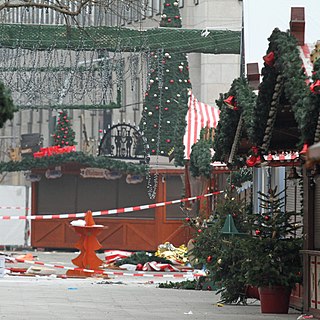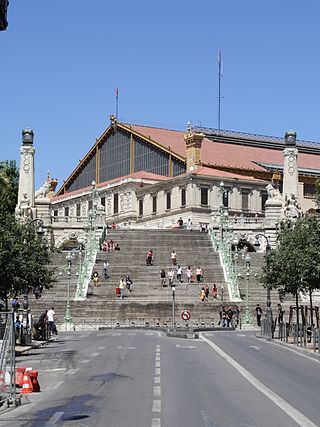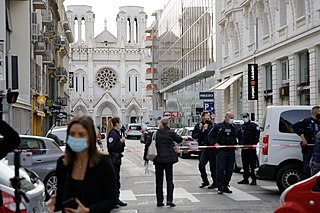| January 2016 Paris police station attack | |
|---|---|
| Part of Islamic terrorism in Europe | |
| Location | Paris, France |
| Coordinates | 48°53′06″N2°21′07″E / 48.8851°N 2.3519°E |
| Date | 7 January 2016 c. 11:30 (CET) |
Attack type | Failed attack |
| Weapons | Cleaver |
| Deaths | 1 (the perpetrator) |
| Injured | 0 |
| Perpetrator | Tarek Belgacem |
| Motive | Islamist terrorism inspired by ISIL |
On 7 January 2016 in Paris, a man wearing a fake explosive belt attacked police officers with a meat cleaver while shouting "Allahu Akbar!" He was shot and killed by officers when he failed to obey an order to stop. [1] [2]
The attempted attack took place on the first anniversary of the 2015 Charlie Hebdo shooting. [3]
The failed attack occurred in the Goutte d'Or district where the population is predominantly of north African and sub-Saharan African origin. [4] Belgacem shouted "Allahu Akbar" and pulled out a meat cleaver as he approached a guard at the local police station. He was shot and killed when he ignored orders to halt. His pocket contained a written rambling statement that included a drawing of an ISIS flag, and his pledge of allegiance to the caliphate. [5]
French interior ministry spokesperson Pierre-Henry Brandet said that on the day of the attack, "a man attempted to attack a policeman at the reception of the police station before being hit by shots from the police." A bomb disposal team cleared the site, determining that the explosive vest the attacker wore was fake. [2] News of the attempted attack came after President François Hollande addressed New Year's greetings to France's police and gendarmes, and called for greater cooperation between the security services. [5]
Tarek Belgacem was identified by police in North Rhine-Westphalia as the attacker. He was a Tunisian native who migrated to the European Union via Romania in 2011. [6] [7] Initially, it was known that Belgacem had used at least seven aliases. It was later determined that he had a total of 20 identities in seven countries. [8] [9] He had been posing as an asylum-seeker from Iraq or Syria, [10] and was living in a center for asylum-seekers in Recklinghausen, Germany, since August 2015. By 11 January, it was reported the suspect had surfaced in Germany in 2013 after living in France for five years. [7] [11] Police found an Arabic banner reading "Islamic State forever" on the wall of a communal kitchen in the center. At the site of the attack, Paris police officers found "a piece of paper on the man's body with the Muslim profession of faith, a drawing of the Islamic State of Iraq and the Levant (ISIL) flag and a pledge of allegiance to the extremist group's leader, Abu Bakr al-Baghdadi". The suspect was also carrying a cellphone with a German SIM card. [11]
Belgacem drew attention to himself at the asylum center where he lived under false pretenses by drawing of the Black Flag of the Islamic State on the wall and by taking photographs of himself with an ISIS flag. [5] He had been living in the asylum center since August 2015 under the name of Walid Salihi, one of his 20 aliases, and the name under which he applied for asylum in countries including Austria, Italy, Luxembourg, Switzerland, Germany, Sweden, and Romania. [6]
The attempted attack received widespread media attention, especially in Germany, due to the North Rhine-Westphalia police conducting several raids in refugee residences throughout the state following the attack and also hundreds of sexual assaults and thefts that occurred across the country on New Year's Eve. On 22 January the Recklinghausen residence, where Belgacem lived before the attack, was searched by the police. The police unsuccessfully tried to find evidence implicating Belgacem as a member of a terrorist cell. Though the attack was unsuccessful, it demonstrated a link between the migrant influx and terrorism, [12] [13] [14] and that asylum seekers with criminal or terrorist intentions can enter Europe without problems and move freely within it. As the Cologne incidents the case Belgacem was also expected to intensify the discussions on the handling of criminal asylum seekers. [14]
Some German politicians and national organisations such as Deutscher Städte- und Gemeindebund (German Association of Towns and Municipalities) demanded better identification and unique registration of the refugees in order to crack down on immigrants living under multiple or false identities like Belgacem did. [15] Uwe Jacob, the director of police in the German state of North Rhine-Westphalia, called for better coordination among EU police in tracking asylum seekers and preventing similar attacks in the future. [6] The concern of the president of the Bundesamt für Verfassungsschutz (Federal Office for the Protection of the Constitution), Hans-Georg Maaßen, that terrorists mingled among the refugees proved true again on 4 February, during further police raids at refugee residences among others in Attendorn. In one such refugee residence, a 35-year-old alleged ISIL terrorist from Algeria was detained, who was reported to have planned a terror attack in Berlin, which was compared with the Recklinghausen case because both perpetrators used multiple identities. German police investigated 19 similar cases as well in February 2016. [16]
In light of the attack, and a shooting on a U.S. police officer on the same day, officers of the New York City Police Department were instructed to "exercise heightened vigilance" and take "proactive measures". [17]
Relatives of Belgacem have filed a suit in a French court alleging that the French police used undue force. [18]

On 7 January 2015, at about 11:30 a.m. in Paris, France, the employees of the French satirical weekly magazine Charlie Hebdo were targeted in a shooting attack by two French-born Algerian Muslim brothers, Saïd Kouachi and Chérif Kouachi. Armed with rifles and other weapons, the duo murdered 12 people and injured 11 others; they identified themselves as members of al-Qaeda in the Arabian Peninsula, which claimed responsibility for the attack. They fled after the shooting, triggering a manhunt, and were killed by the GIGN on 9 January. The Kouachi brothers' attack was followed by several related Islamist terrorist attacks across the Île-de-France between 7 and 9 January 2015, including the Hypercacher kosher supermarket siege, in which a French-born Malian Muslim took hostages and murdered four people before being killed by French commandos.

Amedy Coulibaly was a Malian-French man who was the prime suspect in the Montrouge shooting, in which municipal police officer Clarissa Jean-Philippe was shot and killed, and was the hostage-taker and gunman in the Hypercacher Kosher Supermarket siege, in which he killed four hostages before being fatally shot by police.

On 15 January 2015, Belgian police carried out a raid on premises in Verviers, Belgium. According to news sources, the raids were an anti-terrorist operation against Islamist radicals.

A series of coordinated Islamist terrorist attacks took place on Friday, 13 November 2015 in Paris, France, and the city's northern suburb, Saint-Denis. Beginning at 21:16, three suicide bombers struck outside the Stade de France in Saint-Denis, during an international football match, after failing to gain entry to the stadium. Another group of attackers then fired on crowded cafés and restaurants in Paris, with one of them also detonating an explosive, killing himself in the process. A third group carried out another mass shooting and took hostages at an Eagles of Death Metal concert attended by 1,500 people in the Bataclan theatre, leading to a stand-off with police. The attackers were either shot or detonated suicide vests when police raided the theatre.
The 2016 Munich knife attack took place on 10 May 2016 when a 27-year-old mentally disturbed man stabbed four men, one of them fatally at Grafing station in the Upper Bavarian town of Grafing, some 32 kilometres (20 mi) from Munich, southern Germany. As the knifer reportedly shouted "Allahu Akbar" while stabbing the random victims, first reactions of the German and international media as well as the general public suspected an Islamist attack. On his arrest shortly after the attack, the perpetrator proved to be a mentally disturbed, unemployed carpenter with drug problems and no known ties to Islamist organizations. In August 2017, the Landgericht München II ruled the man to not be criminally liable of the crime and committed him to a closed psychiatric ward.
On 13 June 2016, a police officer and his partner, a police secretary, were stabbed to death in their home in Magnanville, France, located about 55 km (34 mi) west of Paris, by a man convicted in 2013 of associating with a group planning terrorist acts. Amaq News Agency, an online outlet said to be sponsored by the Islamic State of Iraq and the Levant (ISIL), said that a source had claimed that ISIL was behind the attack, an assertion that was later validated.

On 18 July 2016, Riaz Khan Ahmadzai, a 17-year-old refugee from Afghanistan, stabbed and injured five people on and outside a train near Würzburg, Germany. He was shot dead by police soon afterwards, after attacking a police tactical unit with an axe. Investigations revealed he was in contact with members of the Islamic State.

Islamic terrorism in Europe has been carried out by the Islamic State (ISIL) or Al-Qaeda as well as Islamist lone wolves since the late 20th century. Europol, which releases the annual EU Terrorism Situation and Trend report (TE-SAT), used the term "Islamist terrorism" in the years 2006–2010, "religiously inspired terrorism" 2011–2014, and has used "jihadist terrorism" since 2015. Europol defines jihadism as "a violent ideology exploiting traditional Islamic concepts".

On 19 December 2016, a truck was deliberately driven into the Christmas market next to the Kaiser Wilhelm Memorial Church at Breitscheidplatz in Berlin, leaving 12 people dead and 56 others injured. One of the victims was the truck's original driver, Łukasz Urban, who was found shot dead in the passenger seat. The truck was eventually stopped by its automatic brakes. The perpetrator was Anis Amri, an unsuccessful asylum seeker from Tunisia. Four days after the attack, he was killed in a shootout with police near Milan in Italy. An initial suspect was arrested and later released due to lack of evidence. Nearly five years after the attack, a man who was critically injured during the attack died from complications related to his wounds, becoming the 13th victim. As of December 2023, this attack remains the worst Islamist terrorist attack by number of casualties in German history.

ISIL-related terrorist attacks in France refers to the terrorist activity of the Islamic State in France, including attacks committed by Islamic State-inspired lone wolves. The French military operation Opération Sentinelle has been ongoing in France since the January 2015 Île-de-France attacks.
On 3 February 2017, an Egyptian national in France on a tourist visa was shot as he rushed a group of French soldiers guarding a principal entrance to the Louvre Museum in Paris, France, with a machete. One soldier was injured in the fight. The soldiers were patrolling the museum as part of Opération Sentinelle, guarding the Carrousel du Louvre, in which an underground shopping mall also serves as a gift shop, ticket sales office, and public entrance to the museum.
On 19 June 2017, a car loaded with guns and explosives was rammed into a convoy of Gendarmerie vehicles on the Champs-Élysées in Paris, France. The driver, identified as Djaziri Adam Lotfi was killed as a detonation clouded the car in orange smoke. The attacker had been on terrorism watchlists for Islamic extremism since 2014, and pledged his allegiance to Islamic State leader Abu Bakr al-Baghdadi before the attack. In a letter to his family he stated that for years he had supported "the Mujahedeen who fight to save Islam and the Muslims," having practiced shooting "to prepare for jihad," and stated that the attack should be treated as a "martyrdom operation."

On 20 June 2017, a terrorist bomb caused a small explosion at Brussels-Central railway station in Brussels, Belgium; there were no casualties. Soldiers patrolling the station subsequently killed the suspect with three to four shots, according to eyewitnesses. The perpetrator was Oussama Zariouh, a 36-year-old Moroccan national who lived in the Molenbeek municipality and who had assembled a defective explosive device.

The 2017 Turku attack took place on 18 August 2017 at around 16:02–16:05 (UTC+3) when 10 people were stabbed in central Turku, Southwest Finland. Two women were killed in the attack and eight people sustained injuries.

On 1 October 2017, a man killed two women at the Saint-Charles train station in Marseille, France. The women, 20-year-old and 21-year-old cousins, were attacked by an illegal immigrant from Tunisia using a knife. Patrolling soldiers, who had been deployed on national soil following an increase in Islamic terrorist threats, shot him dead at the scene. The brother of the attacker was later arrested and faced preliminary charges of suspicion of involvement in the train station attack. French police were cautious as to whether it was a terrorist attack, but it was later classified as jihadist terrorism by Europol.

On 12 May 2018, a 20-year-old Chechnya-born French citizen, armed with a knife, killed one pedestrian and injured four others near the Palais Garnier opera house in Paris, France, before being fatally shot by police. The stabbings were in the area of Rue Saint-Augustin and Passage Choiseul. French President Emmanuel Macron said France had "paid once again the price of blood but will not cede an inch to the enemies of freedom." The suspect, identified as Khamzat Azimov, had been on a counter-terrorism watchlist since 2016. Amaq News Agency posted a video of a hooded person pledging allegiance to Islamic State of Iraq and the Levant (ISIL) leader Abu Bakr al-Baghdadi, claimed to be the attacker. Europol classified the attack as jihadist terrorism.

On the morning of 29 October 2020, three people were killed in a stabbing attack at Notre-Dame de Nice, a Roman Catholic basilica in Nice, France. The alleged attacker, Tunisian man Brahim Aouissaoui, was shot by the police and taken into custody. Both French President Emmanuel Macron and the mayor of Nice, Christian Estrosi, said it was a terrorist attack attributed to Islamic extremism.
The 2021 Würzburg stabbing occurred on 25 June 2021 in Würzburg, Germany. Abdirahman Jibril, a 24-year-old homeless man of Somalian nationality killed three civilians with a kitchen knife in a Woolworth store and wounded seven others. Minutes later, the police shot the suspect into his leg and arrested him. He had a history of several violent altrications since his 2015 arrival as an asylum seeker in Germany and one day involuntary commitment into a psychiatric hospital a month before the attack. Islamist motives were suspected; he himself said the attack was 'his jihad'. Another refugee accused him to be an al-Shabaab member, who had killed civilians, journalist and police officers in Somalia, which German authorities could not confirm.